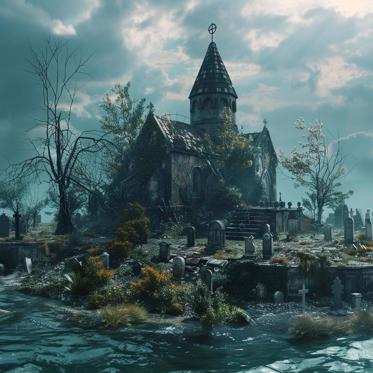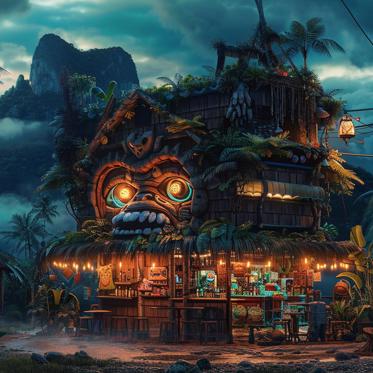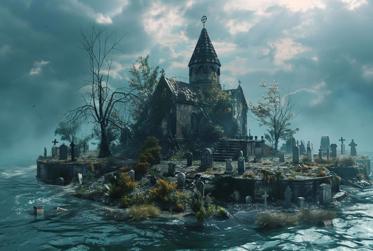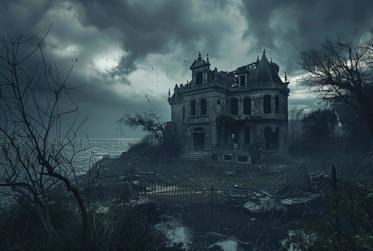Lying out over the horizon, and sometimes right offshore, are islands that seem to be caught in their own world. These islands keep close to them a pervading sense of dread and possibly supernatural forces from beyond our understanding. Let's take a look at yet more of some of the most ghost-filled islands in the world, which are haunted, cursed, or both.
One of the most haunted islands in the world lies within view of the metropolis of San Francisco, California. Built upon a rocky outcropping sitting within the cold, turbulent waters of San Francisco Bay, California, Alcatraz Federal Penitentiary was originally a fort and prison camp for military prisoners in the 1850s, but was built into a fully functioning prison facility that opened for operations in August of 1934. This was not a nice place to be from the beginning, designated as a destination for the worst of the worst, and housing those federal prisoners who had proven to be too unruly or dangerous to be kept in other, more normal prisons. With its state-of-the-art facilities and surrounded by frigid waters with strong currents, the prison was highly feared by prisoners, as it was considered to be well-nigh escape-proof. Over its years of operation, it would be host to a veritable who’s who of the most notorious federal prisoners of the era, including Al Capone, Robert Franklin Stroud (the "Birdman of Alcatraz"), George "Machine Gun" Kelly, Bumpy Johnson, Rafael Cancel Miranda, Mickey Cohen, Arthur R. "Doc" Barker, Whitey Bulger, and Alvin "Creepy" Karpis. Alcatraz would close on March 21, 1963, due to high maintenance costs and the populace’s apprehension about having a rock inhabited by society’s worst just a stone’s throw away from shore, but it would retain its dark reputation well after its closure and has gone on to be considered one of the most haunted places in the world.
Considering the horrific conditions that prisoners faced here, including primitive, cramped cells, brutal punishment dished out for the slightest slights, and regular trips to solitary confinement, as well as the number of people who actually died here from mistreatment, murder, suicide, or failed bids to escape, it is perhaps no wonder that Alcatraz has maintained a reputation as being intensely haunted. It is a place absolutely permeated with suffering and death, and this seems to have had an impact on the amount of ghostly activity reported from here. Yet, as haunted as the whole island seems to be, no part of the island seems to really compare to the notorious area of the prison referred to as D-Block. It is a dank, gloomy place that to this day maintains a heavy sense of desolate bleakness, and its history as a terrifying hellhole and one of the most haunted places in the former prison are well deserved.

D-Block was one of four separate cell blocks on Alcatraz, with A to C blocks being pretty grim, but cell block D was by far the worst. This was where the most incorrigible, out-of-control prisoners were sent as a last resort to be harshly punished and dealt with for behaving particularly badly. Here was located the notorious area called “The Hole,” which was an array of solitary confinement cells equipped with nothing other than a hole in the floor as a toilet, one light bulb, and a mattress, with food shoved through a slit in the door for the prisoner to eat in utter blackness. There were also what were called “Strip Cells” here, where prisoners would be forced to strip down naked and languish and wallow about in their own filth and absolute pitch black solitude in what was little more than poorly ventilated boxes, where they would be given just enough bread and water to not die. Those who were in D-Block were almost like the living dead, alive but not really living, and prisoners were terrified of being sent there, the possibility hanging over their heads like the specter of death. In fact, for many death would have been preferable. D-Block was a bad place to be, is what I’m saying.
The stories of paranormal terror in D-Block started even before the prison was closed down. One of the most sinister cases of horrifying weirdness from the forsaken block supposedly happened in the 1940s, at the nefarious cell 14-D, also rather puzzlingly referred to as “The Oriental.” The tale goes that a prisoner was stripped naked and tossed into the eternally dark cell with nothing but a hole in the ground and any prayers he still had in him. For the next two days, he was kept in that filthy, abyssal hellhole, and it is reported that he would relentlessly scream out in utter desperation and despondency all through the night, with it all picking up when his voice flew into a panic and he shrieked that he was being attacked by a glowing-eyed demonic presence. It was all ignored and chalked up to the deranged rantings of the hopeless, but the screams suddenly went quiet, and when the cell was opened the prisoner was allegedly found to be quite dead, face purple, and with evidence of having been strangled to death by powerful hands. Theories have flown that it was everything from a real demon to a fed-up guard who had simply been sick of hearing his screaming, but it is an eerie story nevertheless.
In the days after this tragic incident, other prisoners and even guards would claim to see the doomed dead man walking amongst their ranks, completely life-like and looking as if he was none the worse for wear until he would vanish in the blink of an eye as they looked on. Cell 14-D had another tragedy when prisoners Rufe McCain and Henri Young were sent there after trying to escape the prison unsuccessfully. Shortly after being released from the cell Young reportedly went into a trance and stabbed McCain in the furniture yard, seriously injuring him. They were both again put into solitary confinement for nearly a year, and their ghosts are said to have been seen wandering about call block D ever since, still doomed to languish there for perhaps eternity.
The ominous cell 14-D has gone on to accrue a rather notorious reputation in the former prison even to this day and is ground zero for some of the most noticeable paranormal phenomena in all of Alcatraz. Here one can supposedly hear disembodied shrieks or clanging sounds, be pushed by unseen hands, and feel undeniable cold spots, with the temperature inexplicably at least around 2 degrees cooler in this one cell than the others year-round, and often up to 20 to 30 degrees Fahrenheit colder than anywhere else. There is also an indescribable feeling of dread that smothers this one cell as if something is bearing down on it and relentlessly channeling negative energy from some other place. There have also been reported the presence of a shadow with glowing eyes, the smell of smoke but no fire, the sounds of crying or moaning, disembodied footsteps, a strange rotting stench that comes and goes suddenly, and suddenly empty cell phone batteries in 14-D, as well as a thick sense of incredible fury, and it has managed to uphold a reputation as being the most haunted cell in all of Alcatraz, which already has plenty of hauntings in the other blocks as well. Cells 11, 12, and 13 of D-Block are also well-known for their strange phenomena and deep sense of intense terror, to the point where some visitors refuse to enter them, with some psychic mediums who have come here insisting there is an extremely malevolent force lurking in D-Black that is not human in origin.

Of course, there have been investigations into the various hauntings of Alcatraz and especially the notorious D-Block. Authors Richard Winer and Nancy Osborn went to the infamous cell 14-D to investigate and were immediately aware of how much noticeably colder it was than its surroundings. They would claim that they had then felt an overwhelming, unbearably malignant presence in the room and an “intense tingling” throughout their hands and arms. In one corner of the cell, they could sense a white-hot point of spiritual energy the likes of which they had never experienced, and Osborne would claim that she had never felt such a strong presence in her entire career of paranormal investigations. Another researcher who came here was ghost hunter Richard Senate, who gathered up the courage to have himself locked into cell 12-D, upon which he says he immediately felt a malicious presence in there with him and unseen hands grab at his neck, as well as a stifling feeling of anger that hit him like a freight train, causing him to abort his investigation and scream to be let out. Psychic Michael Kouri came to cell block D in 1984 and claimed to have actually made contact with one of its spirits, who told him he had been brutally beaten and his legs broken by guards there.
Probably the most well-known and spectacular investigation done of Alcatraz and its cell block D was carried out by the TV show Ghost Adventures with host Zak Bagans. For a season 8 episode, the team made their way to the forlorn Alcatraz Island and would experience a whole range of strange phenomena at cell block D. They would hear anomalous noises such as clanking or banging, witness mist like balls, orbs, and fleeting apparitions, and feel a distinct, sharp discomfort, and Zak would claim to have seen two glowing eyes peering at him through a small slit. EVP (electronic voice phenomenon) and “spirit box” readings were pretty spooky to say the least, capturing voices that said myriad eerie things such as “Fire,” “threshold,” mist,” “come back,” “get naked,” “he's here,” and “dead god,” among others.
It certainly appears that at an already very haunted place, with ghostly phenomena reported all over the island, cell block D particularly stands up as a wellspring of sinister forces. Why should this place be so incredibly steeped in malevolence and ghostly activity? One reason could be the pure amount of suffering and death this place is infused with, which has imprinted itself upon the very fabric of the place or kept the ghosts of these poor souls tethered here. Another idea is that the entities here are not human in origin at all, but rather some other forces that have come here to feed on this negative energy and engorge themselves on it, drawn by that very history of pain and suffering. Interestingly the Native Americans of the area long believed the island to be a gathering place for evil spirits long before it was ever a prison, so perhaps this had something to do with it all. Whatever the causes and origins may be, D-Block is a tormenting, horrible place even in these modern days well past when prisoners were actually kept there, and it undeniably remains the most haunted place in one of the most haunted locations in the United States.
Moving over to Europe, for years, a quaint, pristine island in the middle of one of Europe’s hottest tourist destinations has sat on the market for a rock-bottom price, left untouched and unwanted in an area frequented by some of the world’s richest and most famous people. Here one can find everything they expect in a romantic island getaway, with private beaches, gorgeous views, and a charming villa, as well as some things one might not expect, lurking under the stunning postcard-perfect veneer. For this island carries with it a grim past and perhaps even ghosts. Welcome to Daksa island, a place perhaps inhabited by the dead and which you can apparently even own right now.

Located on the coast of the Adriatic Sea, in the region of Dalmatia in Croatia, there is the prosperous and historical city of Dubrovnik. The city is a UNESCO World Heritage Site and is renowned as a premiere tourist spot throughout Europe and indeed the world, a vacation spot that has played host over the years to such big-name stars as Catherine Zeta-Jones, Michael Douglas, Gwyneth Paltrow, Tom Cruise, Sharon Stone, Clint Eastwood, and Steven Spielberg. Situated just 1.5 nautical miles from this resort paradise, just in front of Dubrovnik’s port Gruz, is a tiny island known as Daksa, a name derived from the Greek word deksios, meaning “right hand.” Long known as a haven for sailors seeking to take shelter from foul weather and once home to a 13th-century Franciscan monastery, the island is the smallest of the Elaphite archipelago, being a mere 500 meters long and 200 meters wide for a total area of just 0.07 km2 (17 acres). Despite its picturesque cypress woodland, orange grove, quaint lighthouse, ruins, and attractive, idyllic views, Daksa could easily be mistaken for just another of Croatia’s 10,000 other Adriatic islands and islets. However, this tiny uninhabited speck of land sitting practically a stone’s throw from one of Europe’s most prestigious resort cities has a dark shadow hanging over its history and is the scene of one of the most violent, horrific incidents the region has ever seen.
For most of World War II, the country of Croatia did not even exist, instead being a part of Yugoslavia and invaded by Nazi forces at the start of the war. The Germans went to great lengths to capitalize on the Croatians’ contempt for the Serbs, who they thought had been given too much power since Yugoslavia had been created at the end of World War I. Under Nazi control, Croatia was made an independent state, and Croatian soldiers were pressured to change sides. At the same time, a vicious campaign of persecution was launched against the Serbs, Jews, Gypsies, and Croatians not loyal to the fascist Ustaša regime (Croatian Revolutionary Movement) which the Nazis had put into power. Through a merciless bloodbath of violence, massacres, and the notorious Jasenovac concentration camp, it is estimated that hundreds of thousands of people lost their lives in these dark days. This black cloud of violence hanging over the region did not lift until the Nazi backed Ustaša fell from power and Croatia became a republic within the Socialist Federal Republic of Yugoslavia.
Considering the ruthless slaughter and suffering they had endured, it is perhaps not surprising that many of the Croatians under this new government still had a bad taste in their mouth concerning the Nazis, and were intent on getting vengeance against those who had oppressed them and their sympathizers. This seething lust for revenge boiled until 18 October 1944, when a mob of Yugoslav Partisans howling for blood descended upon the city of Dubrovnik and proceeded to start arbitrarily arresting anyone who they thought could be a Nazi or Nazi supporter. In total, more than 300 citizens of the city were rounded up, including the newly appointed mayor of Dubrovnik, Niko Koprivica, and the local parish priest, Petar Perica. 53 of them, along with the mayor and priest, were brought over to the uninhabited island of Daksa, where the prisoners awaited a horrible fate amidst its ruins and quaint seaside views.

Here on the island of Daksa, every last one of the 53 prisoners was mercilessly executed without any trial, mostly by a gunshot to the head. The bodies of the dead were more or less left to rot where they fell, being unceremoniously dumped into two shallow mass graves. When the ruthless executioners returned to the mainland after carrying out their dark work, they distributed flyers throughout Dubrovnik that announced that a number of the residents of the city had been sentenced to death by firing squad “in the name of peoples of Yugoslavia,” as well as the victims’ names. The outraged relatives of those killed, many of which staunchly denied any involvement with the Nazis, were further told that the same fate would await them if they should feel the inclination to go investigate the island where their loved ones had been gunned down in cold blood. Interestingly, at the time only the names of 35 of the victims were listed in the flyer and this would be the official number for many decades, as no one bothered to venture to Daksa to check it out.
It was not until September 2009 that the gruesome truth would start to come to light. It was then that an initial six bodies were uncovered on Daksa, and after that, the president of the Croatian Helsinki Committee, Ivo Banac, called for an investigation. An archeological examination of the island was launched, which uncovered two separate grave sites, one of which was located within an old farmhouse basement, and anthropological examinations of the remains that were found identified a total of 53 distinct victims who were all male. Along with the remains was an assortment of various other objects such as buttons, necklaces, rosaries, a priestly collar, crosses, bullets and bullet shells. It was not until June of 2010 that many of the remains were moved back to the mainland and finally given a proper burial after rotting in their shallow graves for over 60 years. Although 53 sets of remains were found, it is believed that there could be even more buried somewhere on the island that have not been unearthed yet. Despite the ghastly nature of the findings and the callous barbarity of the massacre, not a single person has ever been arrested or tried, and the guilt or innocence of the victims has never been established.
It is perhaps this bloody, dark history and the lack of justice in no one ever answering for the crime that has made the island of Daksa unsurprisingly an allegedly intensely haunted place. Those who come here report of hearing voices whisper in their ear or a profound sense of being watched, as well as an almost palpable sense of panic and dread. Even more frightening is that disembodied voices of the unjustly murdered are said on occasion to howl at visitors to go away, and those who do venture upon the deserted island have reported all manner of ghostly activity, such as being pushed, poked, scratched, and shoved by unseen hands. Rowboats that approach the island are also sometimes said to experience being rocked or banged from the bottom by some invisible force. There are also apparently many apparitions and shadow figures that are regularly seen lurking about the island, particularly in the vicinity of the mass graves, as well as orbs and mysterious lights. These rumors of restless, vengeful ghosts are so pervasive that it is enough to keep most people from daring to venture to this otherwise pristine, romantic locale, even during peak tourist seasons. Even the current owners of the island, Nila Perica Dusilo Florshutz and Franica Dusilo Cavich, won’t live there, and they have indeed been actively seeking to sell it for years.
Daksa was actually put up for sale by the owners for an original asking price of 6 million dollars, but the persistent spooky rumors and numerous reports of ghosts on the island have long scared off potential buyers, with the price falling steadily over the years to a mere 2 million euros. With its unspoiled attractive woodland landscape, spacious villa, citrus groves, boathouse, dock, lighthouse, private beaches, and charming views of the sea, this would seem to be a steal for a whole private island, yet even in this paradise among other surrounding islets owned by the rich and famous, no buyers have ever come forward to make an offer or to even come make a viewing. It would seem that most people do not find the thought of living on an island so wrapped in a gruesome dark history to be very appealing, whether there are actually ghosts there or not. Perhaps it is better this way. Perhaps it is better to leave any shadowy denizens of the island alone amongst the picturesque scenery, where they can seethe in their eternal anger in solitude, and where the ire spurred by the anguished memories of their wicked past will not spill over and harm the living. Or, if you don’t believe in that sort of thing and have 2 million euros lying around, you could own your own haunted island for a bargain, as well as a piece of sinister history. Just remember that as you sit out on the beach enjoying your new purchase, there is a chance that you may not be alone.

Some haunted islands have pasts going back to truly ancient times. Out among the many islands of the Federated States of Micronesia, in the western Pacific Ocean, is a rather curious place imbued with its own colorful past and myriad mysteries spread out under the tropical sun and ringed by white sand beaches. Here, connected to the eastern coast of the Micronesian island of Pohnpei and lying within a lagoon is an impressive array of 92 artificial islets intersected by canals and built up with walls, columns, and other megalithic structures composed of coral and volcanic basalt, and the ruins of an ancient city mired in mystery. Indeed, this place, called Nan Madol, has managed to defy most attempts to explain its structures, and the so-called “eighth wonder of the world,” or the "Venice of the Pacific" has managed to remain a perplexing mystery to this day.
Among the many mysteries of these islets is that no one is really sure why they are here or how their enigmatic structures were built, and very little is even really known about the history of this place. It is known that Nan Madol once served as the capital of the local Saudeleur Dynasty all the way until 1628 before mysteriously abandoning it, that different islets seem to have served different purposes, and that this place was inhabited by high-ranking priests and chiefs, but considering the total lack of any written record that is really all we know for sure. As for the megalithic architecture, this has created a profound conundrum among archeologists, as no one can figure out how just they did it.

It is thought that Nan Madol’s megalithic architecture was constructed beginning in around 1180–1200 AD, and the proportions of these walls and structures are vast in scale. Many of the gigantic basalt logs used to build much of it weigh anywhere from 5 to 50 tons each, and there are hundreds of them meticulously formed into immense walls measuring up to 50 feet high and 17 feet thick. There is no archeological evidence of any sort of technology here that could account for such massive blocks being moved here from distant sources over the ocean and hoisted into place, and no evidence anywhere else in the region of anything even approaching this sort of marvel of engineering. Making it all the more befuddling still is that rather than just build these structures on land, the people who created them chose instead to make them upon these elaborate artificial islets at great extra expense and effort. Explorer Ivan Mackerle has said of this oddity:
The peculiar location of the city raises another baffling question. Why was it raised in the ocean waters and not on land? Each structure had to be built on a specially constructed artificial rectangle in the water, edged by long basalt boulders and filled with coral granules. 92 such artificial islets cover the area of 2.5 square kilometers. Why did the early builders come up with this insane idea, demanding the grueling labor of building artificial sea islands when there were so many natural coral reef islands here, or when they could simply clear the shore of a few palm trees?
Considering the utter lack of any written records on their construction and the void of anything even resembling it anywhere else in the history of Micronesia, all of this has left questions and speculation surrounding their construction, and how they were made depends largely on who you ask. The islanders themselves have a rich lore concerning the ruins of Nan Madol. According to them, the structures have been there since before their ancestors even arrived, and they believe the massive stones were magically levitated there by two powerful ancient sorcerers called Olisihpa and Olosohpa, who would go on to create the city and prospering civilization of the Saudeleur kings. The locals claim that beneath the city lie vast networks of tunnels and tombs, and that this was once the land of actual giants and the stomping grounds of various spirits.
Officially, scientists have been unable to really explain how the rocks that make up these structures were transported or put into place, to the point that there isn’t really any theory on how it was all done. The closest they have come is that the blocks were somehow transported upon enormous bamboo or wooden rafts, yet not only is there no archeological evidence of such grand rafts, but modern experiments to replicate this by moving stone columns with rafts have failed with boulders of just 1 or 2 tons, let alone 25 or 50. Making it harder to study is that Nan Madol is largely considered a deeply sacred place by the locals, which they believe should remain undisturbed, and as such archeological digs have long been actively discouraged here, providing further obstacles to learning any more about it.
Indeed, the locals say the place is prowled by guardian spirits who will attack those who dare enter, and that the ancient kings placed potent mystical wards against outsiders on this place. One of the only real extensive archeological investigations into the mysterious islets was made in 1874 by Polish anthropologist Jan Kubary, after which his ship promptly sank to take its valuable artifacts with it. Another story concerning the supposed curse of Nan Madol is the tale of English archeologist F. W. Christian, who supposedly entered a secret tomb within the complex and found the skeletons of actual giants measuring 10 or more feet in height. We will never know if this claim was true or not, because a massive storm is said to have lashed the area at the time, causing him to abandon the investigation, after which he would die of a mysterious illness the following day to take the secret of this mysterious tomb to his grave with him. In later years in the 1900s a German governor on the main island of Pohnpei by the name of Victor Berg supposedly also found a tomb of giants and died not long after from mysterious causes.

Whether there is a curse or not, there has been very little scientific investigation into these ruins at all. However these ancient people did it, we are unable to do it even now with our modern technology, the ruins remain almost a complete enigma, and this general shoulder shrugging within the scientific community concerning Nan Madol has left the door open for all sorts of more fringe theories. One is that the structures were really built by the giants of island lore, and there have been stories to support this. Besides the tale of Kubary finding a tomb of giants and that of the German governor, there were supposedly enormous coffins made of platinum removed by the Japanese just before World War II, but these disappeared into the mists of history. There have also been scattered reports of coming across human bones far larger than normal, but these remain unsubstantiated.
Other theories are that Nan Madol is actually the remnants of some lost civilization or that it is the actual location of such ancient lost lands as Atlantis, Lemuria, or Mu. There is of course the idea that aliens made it, as well as the idea that it was built by Greek sailors in 300 BC, and even that it is some sort of ancient weather manipulation device that works by channeling seismic activity up through the structures to spew into the atmosphere and create storms. For now, it all remains unknown. We still do not know who built this strange place, why, or how, and it remains a place where legends, myths, and historical oddities merge into an almost mystical realm of the unexplained.
One of the creepiest haunted islands there is Mexico's genuinely disturbing island of horrors, La Isla de las Munecas, the immensely creepy and allegedly haunted "Island of Dolls." La Isla de las Munecas is located in the area of Xochimilco, a borough within the Mexican Federal District which was historically positioned on what was once Lake Xochimilco. Xochimilco is a locale well-known for its extensive system of canals, which are a relic of the times when the settlements of the Valley of Mexico were interconnected by networks of canals and lakes.
The island itself is what is known as a chinampas, which are artificial islands built in shallow areas of the lake during the pre-Hispanic period as a means of increasing agricultural production. The chinampas were mounds of earth and mud heaped upon a frame of intertwined juniper branches and tied to the shore. As the islands sank, new ones would be built on top, stacking one over the other until a rectangular island was eventually formed and permanently affixed to the bottom of the lake. Upon these islands were grown a variety of crops, and they were of great economic value during the time of The Aztec Empire. The artificial islands were so lush that they were also known as "floating gardens," and the large number of chinampas constructed subsequently contributed to the gradual shrinking of Lake Xochimilco into the canal system seen today.

In modern times, most of the chinampas have deteriorated and fallen into disrepair, yet around 5,000 remain and they are popular with tourists, who ride along the canals in special gondolas called trajineras. Indeed, due to its important historical connection to pre-Hispanic Mexico, Xochimilco with its ancient man-made islands and canals is deemed a World Heritage Site. However, one of the chinampas that all but the most fearless visitors may want to steer clear of is the menacing Island of Dolls. La Isla de las Munecas is perhaps the most infamous of Xochimilco's chinampas due to its bizarre history and status as one of the spookiest, most haunted places in Mexico. The story begins in the 1950s with a reclusive loner known as Julian Santana Barrera, who took up residence on an abandoned chinampa where he lived in a hut by himself. He then used the artificial island for growing not fruits and vegetables, but nightmare fuel.
After witnessing a young girl drown in a nearby canal, Barrera became convinced that the spirit of the girl was haunting him. He reportedly claimed he could hear the dead girl singing, giggling, and calling to him from over the water, as well as dragging and scratching noises outside of his hut or rapping on the windows when no one else was there. Sometimes he could see her ghostly form through the trees or over the water, hovering about the island at night. Disturbed by these visitations, Barrera's behavior became increasingly erratic. One day, Barerra saw a doll drift by in the water of the canal and took it as a sign. He fished the doll from the water and hung it up on his island believing that it would protect him from the wrath of the girl's ghost. It soon became apparent to him that one doll was simply not enough, as he believed the restless spirit was still tormenting him. Barrera became obsessed with collecting more dolls, sometimes even trading vegetables he had grown for more of them in his desperation to appease the angry spirit of the girl. He hung the dolls all over the island, amassing more and more until eventually there were hundreds of the things strewn all over the place, covering the chiampas. Barrera put the dolls everywhere; on the ground, propped against trees, tied to tree trunks and fences, and even hanging from the branches like twisted Christmas tree ornaments. It is said that he would often rearrange the dolls and frequently move them into different locations and positions about the island as he saw fit.
Word of mouth spread about the odd hermit on this island surrounded by his creepy collection of disheveled dolls, and local legends began to form. It was said that the dolls would come to life at night and roam the island brutally killing animals, and that if one listened carefully the gibbering whispers and giggling of the dolls could be heard as they went about their grim work. It was rumored that Barerra would talk and sing to the dolls, caring for them as if they were real children. It was also said that the dolls became infused with evil as soon as they were put up on the island, and that they were all connected by some insidious supernatural force.

This went on for years until one day Barreras was found dead, floating face down in one of the canals. Chillingly, it was the very same canal the little girl had died in all those years ago, the same girl whose ghost had slowly driven Barrera insane. Local legend has it that Barrera's ghost continued to inhabit the island, haunting it along with the dolls. Today the island's dolls are still there. They are scattered haphazardly all over the island, strung up everywhere, with their dull, wide eyes gazing lifelessly over their domain. Over the years they have deteriorated to the point that most are in various states of disrepair, and many are filthy and decrepit, all of which makes them that much scarier and further fuels the menacing ambiance of the island.
The dark superstition and folklore associated with the island showed no signs of abating with Barrera's death. People say that when visiting the island, it is a good idea to bring a doll with you to appease the dark spirits there. As soon as the new doll arrives, it is believed to connect with the others through whatever black magic it is that courses through them. In addition, Barrera himself is still said to survey the place, watching all who visit from the shadows.
The stories of the paranormal pervading La Isla de las Munecas have also captured the attention of those looking for evidence of such goings on, with the TV show Destination Truth launching an expedition to the island. Barrera's nephew explained to the crew that indeed the dolls seemed to be charged with some eerie supernatural energy and that the island was haunted, cursed, or both. The crew were not disappointed as they managed to experience quite a few strange happenings during their stay. Strange dragging sounds were heard on the roof of the island's shack as well as other creepy noises and bumps in the dark. Sensors for ghostly energy also were going wild with readings and the highlight of the show came when one of the dolls appeared to open its eyes of its own accord when asked to do so. The entire incident was caught on camera. Say what you will about its authenticity or whether it constitutes evidence of the paranormal, but there is no denying that the footage is exceptionally creepy and disturbing.

Such spooky stories have apparently done nothing to stymy the flow of curious visitors looking for a peak at the macabre. Over the years, La Isla de las Munecas has truly become one of the most famous chinampas of Xochimilco based purely on its grim reputation and bizarre history. The island's current tenant, Barrera's own nephew Anastasio Valasquez, says hundreds of people flock to see the island and its dolls every year. For the truly brave, nowadays it is relatively easy to book a tour to see the island and it is easily accessible by ferry or gondola. The visitors may come and go but the dolls remain, twisted bodies strung up upon the trees and beady eyes staring at, perhaps even watching their lair as they have for so long and will likely continue to do until they've turned to dust. Perhaps Barrera is there too among his slowly decomposing dolls, forever to care for them like his own children.
Here we have looked at yet more of the world's most haunted islands, these seemingly forsaken places festering with their secrets out over the waters of our planet. Is there anything to these stories? Perhaps you should take a visit and find out for yourself. And for more such places to visit, check out Part 1 and Part 2 of my Haunted Islands series.
Trending Podcasts
-
 31.17 I MU Podcasts
31.17 I MU Podcasts31.17 - MU Podcast - Battlefield Echoes Reborn
-
 31.18 I MU Podcasts
31.18 I MU Podcasts31.18 - MU Podcast - Bibhu Dev Misra
-
 +29.16 I MU+ Podcasts
+29.16 I MU+ Podcasts29.16 - MU Plus+ Podcast - Echoes of 401
-
 +29.17 I MU+ Podcasts
+29.17 I MU+ Podcasts29.17 - MU Plus+ Podcast - Sleepover Symbiotes
-
 31.16 I MU Podcasts
31.16 I MU Podcasts31.16 - MU Podcast - The Great Crop Circle Hoax
-
 +29.18 I MU+ Podcasts
+29.18 I MU+ Podcasts29.18 - MU Plus+ Podcast - Never Contact Me Again





-373x373.jpg)



-373x251.jpg)


